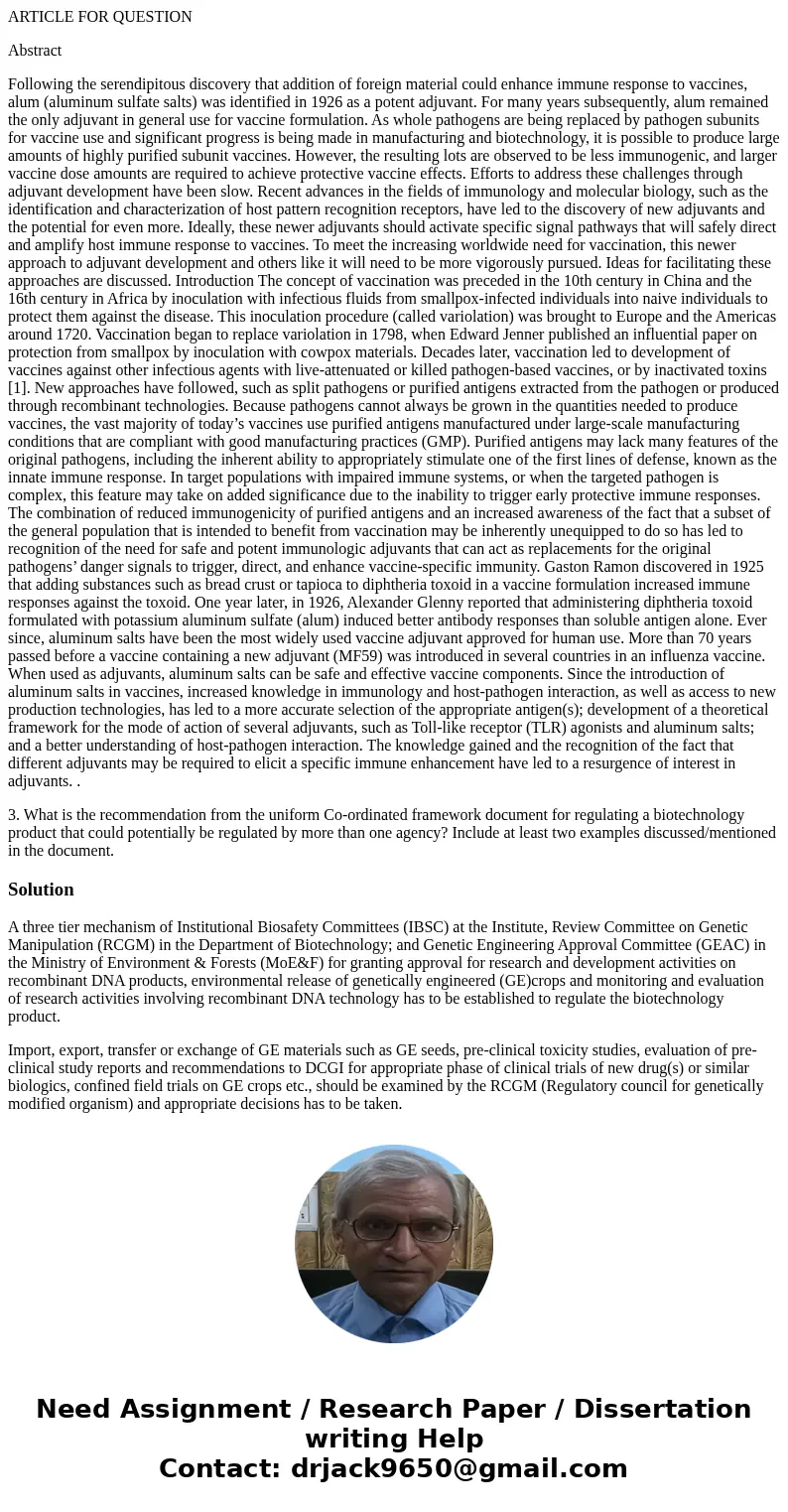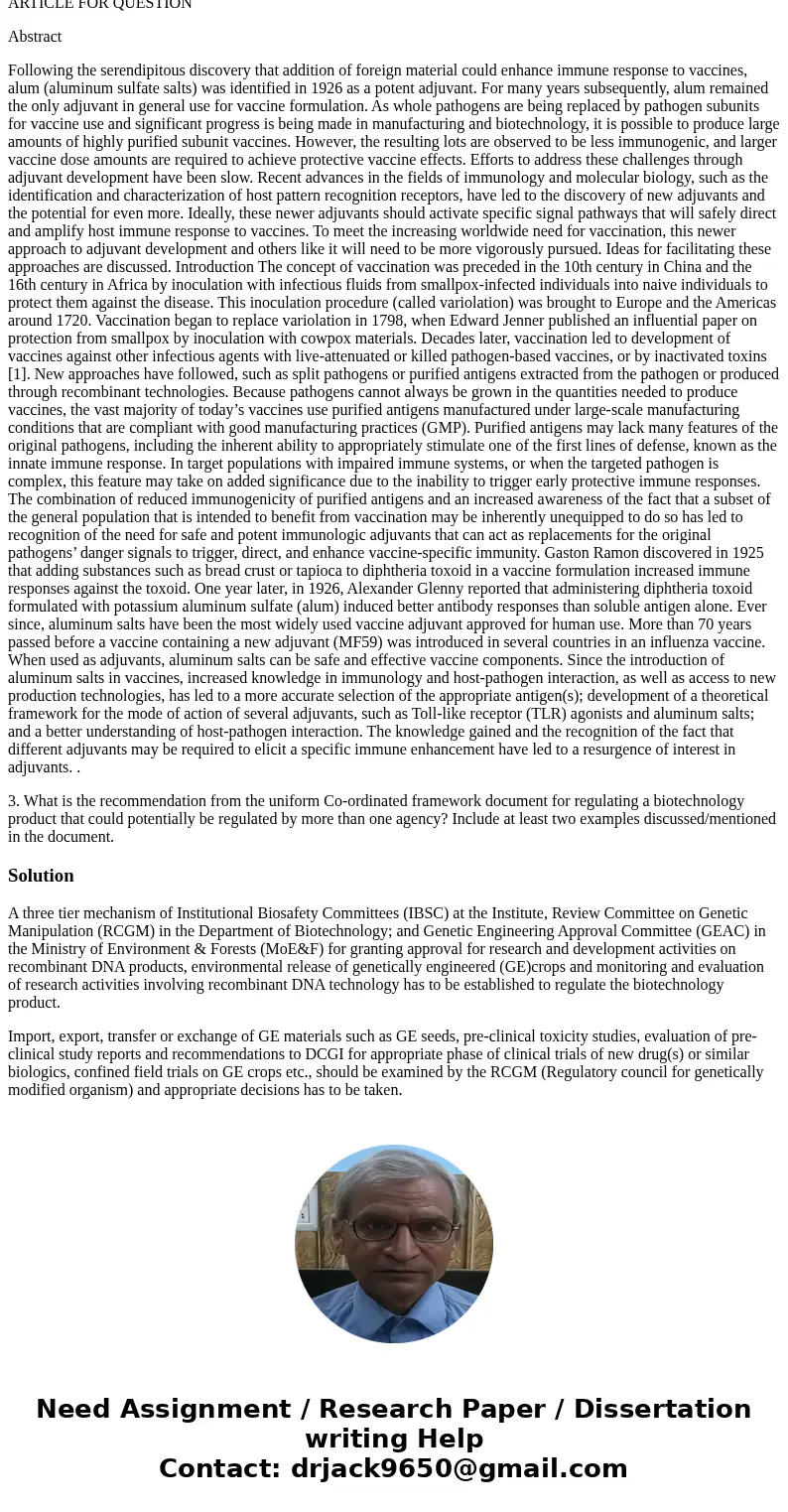ARTICLE FOR QUESTION Abstract Following the serendipitous di
ARTICLE FOR QUESTION
Abstract
Following the serendipitous discovery that addition of foreign material could enhance immune response to vaccines, alum (aluminum sulfate salts) was identified in 1926 as a potent adjuvant. For many years subsequently, alum remained the only adjuvant in general use for vaccine formulation. As whole pathogens are being replaced by pathogen subunits for vaccine use and significant progress is being made in manufacturing and biotechnology, it is possible to produce large amounts of highly purified subunit vaccines. However, the resulting lots are observed to be less immunogenic, and larger vaccine dose amounts are required to achieve protective vaccine effects. Efforts to address these challenges through adjuvant development have been slow. Recent advances in the fields of immunology and molecular biology, such as the identification and characterization of host pattern recognition receptors, have led to the discovery of new adjuvants and the potential for even more. Ideally, these newer adjuvants should activate specific signal pathways that will safely direct and amplify host immune response to vaccines. To meet the increasing worldwide need for vaccination, this newer approach to adjuvant development and others like it will need to be more vigorously pursued. Ideas for facilitating these approaches are discussed. Introduction The concept of vaccination was preceded in the 10th century in China and the 16th century in Africa by inoculation with infectious fluids from smallpox-infected individuals into naive individuals to protect them against the disease. This inoculation procedure (called variolation) was brought to Europe and the Americas around 1720. Vaccination began to replace variolation in 1798, when Edward Jenner published an influential paper on protection from smallpox by inoculation with cowpox materials. Decades later, vaccination led to development of vaccines against other infectious agents with live-attenuated or killed pathogen-based vaccines, or by inactivated toxins [1]. New approaches have followed, such as split pathogens or purified antigens extracted from the pathogen or produced through recombinant technologies. Because pathogens cannot always be grown in the quantities needed to produce vaccines, the vast majority of today’s vaccines use purified antigens manufactured under large-scale manufacturing conditions that are compliant with good manufacturing practices (GMP). Purified antigens may lack many features of the original pathogens, including the inherent ability to appropriately stimulate one of the first lines of defense, known as the innate immune response. In target populations with impaired immune systems, or when the targeted pathogen is complex, this feature may take on added significance due to the inability to trigger early protective immune responses. The combination of reduced immunogenicity of purified antigens and an increased awareness of the fact that a subset of the general population that is intended to benefit from vaccination may be inherently unequipped to do so has led to recognition of the need for safe and potent immunologic adjuvants that can act as replacements for the original pathogens’ danger signals to trigger, direct, and enhance vaccine-specific immunity. Gaston Ramon discovered in 1925 that adding substances such as bread crust or tapioca to diphtheria toxoid in a vaccine formulation increased immune responses against the toxoid. One year later, in 1926, Alexander Glenny reported that administering diphtheria toxoid formulated with potassium aluminum sulfate (alum) induced better antibody responses than soluble antigen alone. Ever since, aluminum salts have been the most widely used vaccine adjuvant approved for human use. More than 70 years passed before a vaccine containing a new adjuvant (MF59) was introduced in several countries in an influenza vaccine. When used as adjuvants, aluminum salts can be safe and effective vaccine components. Since the introduction of aluminum salts in vaccines, increased knowledge in immunology and host-pathogen interaction, as well as access to new production technologies, has led to a more accurate selection of the appropriate antigen(s); development of a theoretical framework for the mode of action of several adjuvants, such as Toll-like receptor (TLR) agonists and aluminum salts; and a better understanding of host-pathogen interaction. The knowledge gained and the recognition of the fact that different adjuvants may be required to elicit a specific immune enhancement have led to a resurgence of interest in adjuvants. .
3. What is the recommendation from the uniform Co-ordinated framework document for regulating a biotechnology product that could potentially be regulated by more than one agency? Include at least two examples discussed/mentioned in the document.
Solution
A three tier mechanism of Institutional Biosafety Committees (IBSC) at the Institute, Review Committee on Genetic Manipulation (RCGM) in the Department of Biotechnology; and Genetic Engineering Approval Committee (GEAC) in the Ministry of Environment & Forests (MoE&F) for granting approval for research and development activities on recombinant DNA products, environmental release of genetically engineered (GE)crops and monitoring and evaluation of research activities involving recombinant DNA technology has to be established to regulate the biotechnology product.
Import, export, transfer or exchange of GE materials such as GE seeds, pre-clinical toxicity studies, evaluation of pre-clinical study reports and recommendations to DCGI for appropriate phase of clinical trials of new drug(s) or similar biologics, confined field trials on GE crops etc., should be examined by the RCGM (Regulatory council for genetically modified organism) and appropriate decisions has to be taken.


 Homework Sourse
Homework Sourse